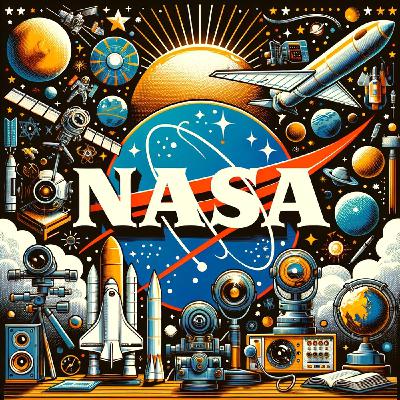Navigating NASA's Shifting Priorities: Exploration, Partnerships, and the Future of Earth Science
Update: 2025-08-25
Description
NASA’s headline this week: the SpaceX Dragon blasted off for its 33rd commercial resupply mission to the International Space Station. This isn’t just another cargo launch; packed aboard are experiments that could reshape medicine on Earth and pave the way for future space exploration. The Dragon’s cargo includes a 3D bioprinter for building implantable medical devices, engineered liver tissue for studying blood vessel growth in microgravity, and materials to 3D print metal—allowing astronauts one step closer to building what they need, when they need it, while orbiting above us. According to NASA officials, these include studies on bone-forming cells to help prevent bone loss, directly benefiting not just astronauts, but millions of Americans affected by osteoporosis.
This mission comes as NASA navigates turbulent policy waters. The White House has proposed a nearly 50% cut to NASA’s science programs, which could eliminate up to 41 missions, drain billions in taxpayer investments, and force a third of NASA’s workforce out the door. Acting NASA Administrator Sean Duffy spoke candidly this week: “Science will now focus on exploration—missions to the moon, Mars, and beyond,” noting a significant step back from Earth and climate science. This policy shift would leave critical gaps in climate monitoring, weather forecasting, and our understanding of Earth’s changing systems, raising concerns for state agencies and researchers who rely on NASA data for disaster response and public safety.
On the organizational front, NASA recently closed three major offices to comply with workforce optimization orders, igniting debate about the future capacity of the agency and the nation’s scientific leadership. As NASA sharpens its focus on exploration, expect more international and private partnerships. For instance, this Dragon mission is part of a broader strategy: as Russia signals it may pull out of the space station program after 2028, NASA is counting on companies like SpaceX and Northrop Grumman to fill the gap and support the ISS through its planned retirement around 2031.
How do these changes impact you? For American citizens, fewer Earth science missions could mean less accurate weather, climate, and hazard data—affecting everything from flood response to farming. U.S. businesses tracking climate risks, students dreaming of space, and local governments planning for the future all have a stake in these decisions. Internationally, the shift could alter America’s scientific standing just as global interest in space intensifies.
If you want a say, NASA and advocacy groups urge you to contact your congressional representatives. And if you’re a student or educator, don’t miss the upcoming NASA crew Q&A livestream on August 27—your chance to connect with astronauts currently aboard the ISS and to see first-hand why this work matters.
Stay tuned for developments as Congress debates the future of NASA’s missions and budget. For more updates and details, visit nasa.gov. Don’t forget to subscribe so you never miss a launch or a science breakthrough.
Thanks for tuning in. This has been a quiet please production, for more check out quiet please dot ai.
For more http://www.quietplease.ai
Get the best deals https://amzn.to/3ODvOta
This content was created in partnership and with the help of Artificial Intelligence AI
This mission comes as NASA navigates turbulent policy waters. The White House has proposed a nearly 50% cut to NASA’s science programs, which could eliminate up to 41 missions, drain billions in taxpayer investments, and force a third of NASA’s workforce out the door. Acting NASA Administrator Sean Duffy spoke candidly this week: “Science will now focus on exploration—missions to the moon, Mars, and beyond,” noting a significant step back from Earth and climate science. This policy shift would leave critical gaps in climate monitoring, weather forecasting, and our understanding of Earth’s changing systems, raising concerns for state agencies and researchers who rely on NASA data for disaster response and public safety.
On the organizational front, NASA recently closed three major offices to comply with workforce optimization orders, igniting debate about the future capacity of the agency and the nation’s scientific leadership. As NASA sharpens its focus on exploration, expect more international and private partnerships. For instance, this Dragon mission is part of a broader strategy: as Russia signals it may pull out of the space station program after 2028, NASA is counting on companies like SpaceX and Northrop Grumman to fill the gap and support the ISS through its planned retirement around 2031.
How do these changes impact you? For American citizens, fewer Earth science missions could mean less accurate weather, climate, and hazard data—affecting everything from flood response to farming. U.S. businesses tracking climate risks, students dreaming of space, and local governments planning for the future all have a stake in these decisions. Internationally, the shift could alter America’s scientific standing just as global interest in space intensifies.
If you want a say, NASA and advocacy groups urge you to contact your congressional representatives. And if you’re a student or educator, don’t miss the upcoming NASA crew Q&A livestream on August 27—your chance to connect with astronauts currently aboard the ISS and to see first-hand why this work matters.
Stay tuned for developments as Congress debates the future of NASA’s missions and budget. For more updates and details, visit nasa.gov. Don’t forget to subscribe so you never miss a launch or a science breakthrough.
Thanks for tuning in. This has been a quiet please production, for more check out quiet please dot ai.
For more http://www.quietplease.ai
Get the best deals https://amzn.to/3ODvOta
This content was created in partnership and with the help of Artificial Intelligence AI
Comments
In Channel





